Vegan pie crusts are tricky to make, but this recipe is the best out there. A no-roll vegan pie crust is an excellent alternative to traditional pie crust, as you press the dough directly into the pie pan. It's easy, delicious, and only takes 10 minutes to prepare! If you're vegan, dairy-free, or just want to eat healthier this Thanksgiving, this recipe is for you.

Ready to level up your plant-based kitchen game? Say hello to this no-roll vegan pie crust that's not just dairy-free but also egg-free. Yep, it's an all-inclusive party for vegans, vegetarians, and anyone with food allergies. The real MVP here? No extra flour is needed for rolling—just mix, press, and you're good to go!
Nail this foolproof vegan pie crust every single time by following the insider tips and tricks we've got for you in this post. Whether you're craving a classic vegan pumpkin pie for those cozy fall vibes or maybe even an apple pie, this versatile dough has got you covered. It's also a superstar for savory vegan pies, tarts, and quiches. So, what are you waiting for? Let's get baking! 🥧🌱
We use this recipe for quiches. For savory tarts, we actually like them less, flaky and manageable, but it's a matter of taste. To make tarts, we recommend our Vegan Empanada dough, which works wonderfully for savory tarts like our vegan eggplant pie or a savory carrot tart.

Jump to:
💚 Why you will love it
This easy, no-roll creation is perfect for both sweet and savory pies. It's the quick and guilt-free option for pie lovers, eliminating the need for chilling and rolling. Just mix and press into the pan—ideal for when you're short on time or patience.
This crust is made with thoughtful plant-based substitutions, ensuring delicious results without dairy. It's versatile, too, ready to complement any pie filling, whether you prefer your crust sweet or savory. Adjust the balance of sugar and salt to match the flavor profile of your pie, making it a flexible recipe that caters to all tastes.
🧾 Ingredients
- All-purpose flour: Provides the structure for the crust, making it sturdy yet tender. If you're gluten-free, check out the notes for a suitable replacement.
- Cold-cubed vegan butter (we like Earth Balance) adds richness and flakiness to the crust. The cold temperature ensures the dough remains easy to work with.
- Salt: Enhances the flavor profile, making the crust more than just a bland base.
- Sugar: Offers a sweetness, balancing the savory elements and making the crust versatile for both sweet and savory pies.
- Ice Water: Helps bind the ingredients together without activating the gluten too much, resulting in a tender crust.
Quantities in the recipe card.
Substitutions
- Vegan Butters: you can use vegetable shortening or coconut oil, but in my experience, vegan butter such as earth balance works better and tastes better. You can also use regular butter if you are not following a vegan diet.
- Sugar: You can use white sugar to have a perfectly white dough; I use natural, organic sugar can, as the amount is minimal, and I can barely notice it is there. We want the dough to be golden drown once cooked. Don't we? Brown sugar contributes to that, but feel free to use regular sugar.
- Milk: All kinds of plant milk are welcome and work well.
- Flour: you can use gluten-free flour. It will just be more crumbly. Here's a great guide on how to use Gluten-Free flour.
🥢 Equipment
Cling (plastic wrap), food processor, spatula, and pie pan.
🔪 Instructions
Ensure your vegan butter is in the freezer for at least 30 minutes before beginning.
I like placing a couple of ice cubes on the water I will use or simply leaving some ice cubes to thaw as I prepare the rest of the ingredients.
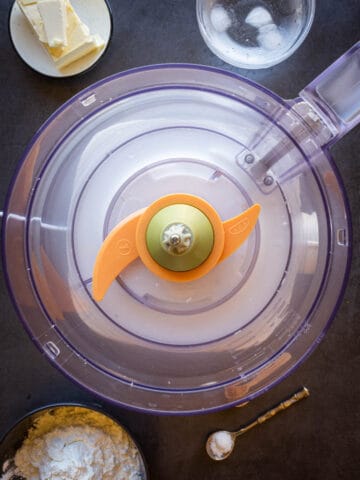
Step 1: Place the plastic spinner of the food processor inside it. If working by hand, use a large bowl (also chilled).
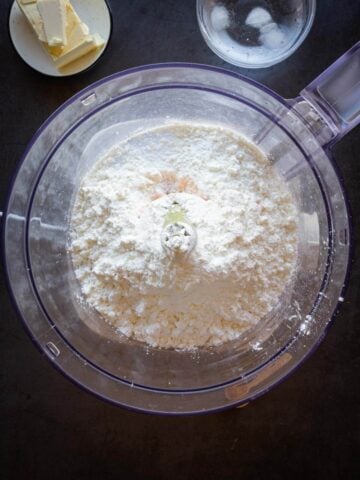
Step 2: Mix the flour, sugar, and salt in a food processor using the plastic spinner; this method is better for making pastry.
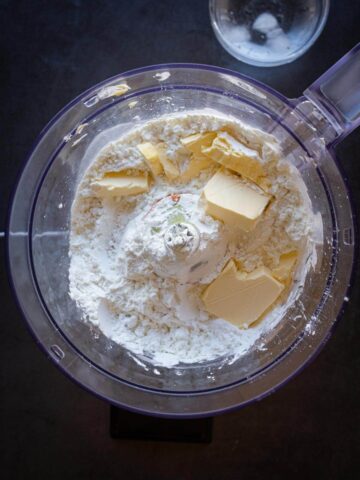
Step 3: Continue adding the butter, beginning with half of it.
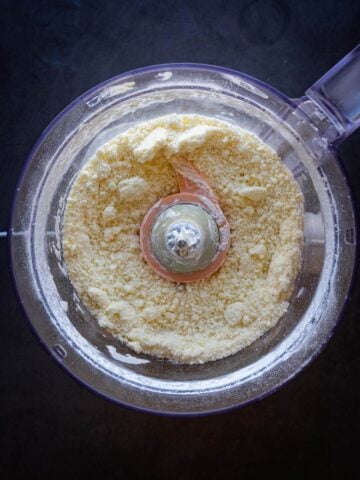
Step 4: Add ice water, then rest after several pulses.
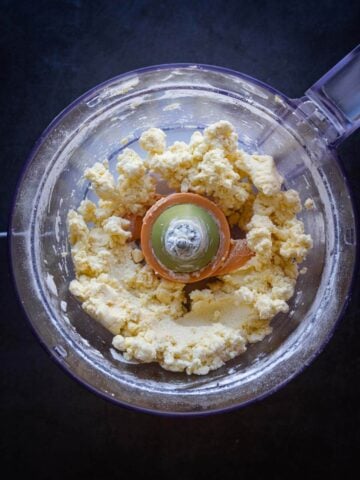
Step 5: Add the remaining butter. Do not overmix; it raises the temperature, and we want to keep the butter temperature.
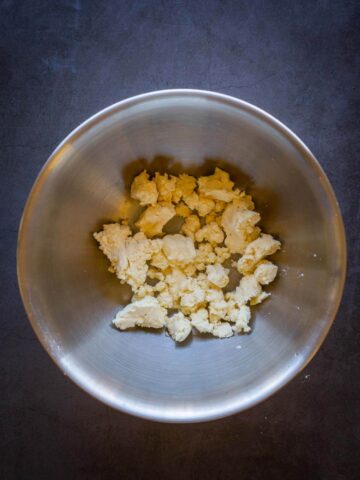
Step 6: Transfer the dough to a bowl.
Heads up: Feel free to ditch the food processor and go old-school by mixing everything by hand. But so that you know, using a food processor gives you that extra assurance that all ingredients are perfectly blended. Plus, it keeps your warm hands off the dough, preventing that vegan butter from turning into a melty mess and messing up the texture we're aiming for.
Alternatively, you can opt for a kitchen machine equipped with a dough hook, miming the hand-kneading action without adding extra heat to your shortcrust pastry.
Whether you go for a food processor with a plastic spinner or a kitchen machine with a dough hook, both options let you focus on crafting the perfect crust without stressing over warming up the mixture.
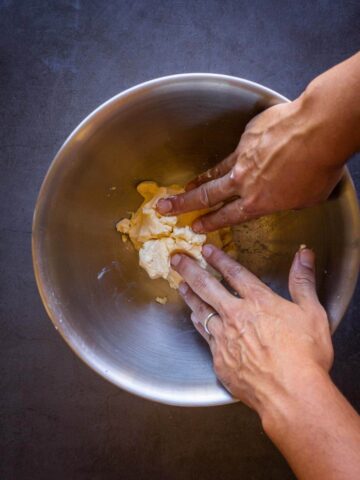
Step 7: Grab a large bowl and mix all the ingredients with a spatula, then switch to using your hands.
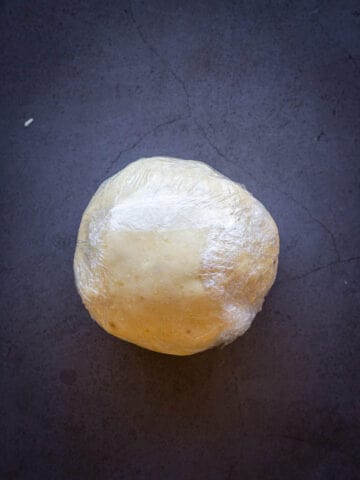
Step 8: The mix is perfect when it looks crumbly inside the food processor. Knead the vegan dough for a few seconds to make it homogeneous, then form it into a ball, wrap it in plastic, and transfer it to the fridge for at least 60 minutes.
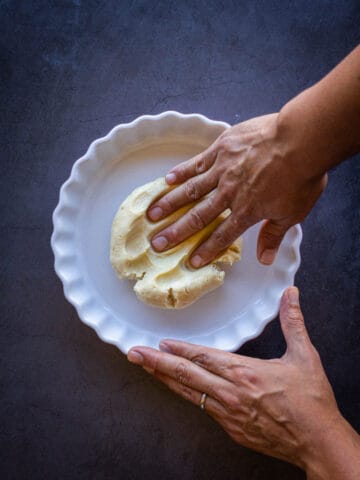
Step 9: Directly stretch the dough into the pie pan with your hands.
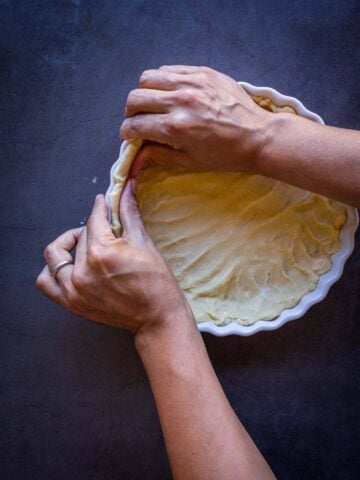
Step 10: Ensure the pie dough is evenly distributed, and no large clumps may turn out undercooked.
Now that you've made the crust with all your favorite ingredients, it's time to fill! Check out our Vegan Pumpkin Pie, and why not? Make your pumpkin spice mix in 5 minutes.
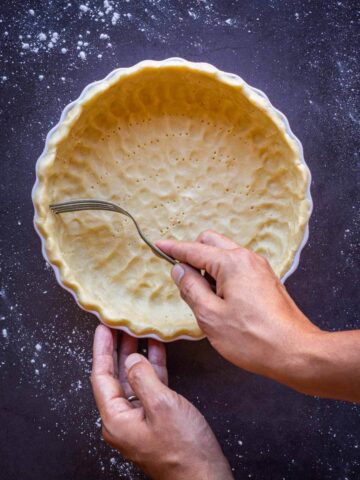
Step 11: Pinch the pie crust with a fork to ensure it is evenly baked both in the bottom corners and the edges.
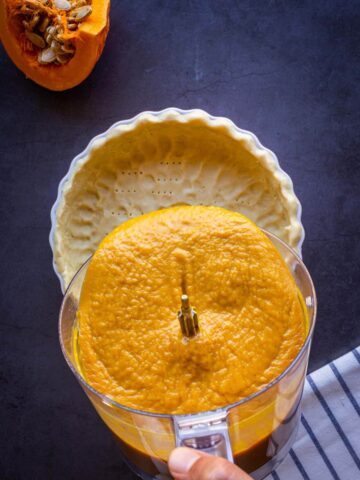
Step 12: Fill with your preferred batter.
💡 Expert Tips
To make the perfect crust, read these tips for vegan bakers and their friends and family. This recipe delivers the best results every time.
Allow the crust to chill in the refrigerator for one hour or up to three days.
When ready for use, allow the dough to rest on the counter for about 15 minutes before using it to make it simpler to handle. This is unnecessary if you use this easy pie crust immediately after the minimum chilling time.
Use plant milk: To make a dairy-free pie crust, use almond, cashew, and soy milk, as they tend to be thicker. Replace dairy vs. non-dairy milk is the easy part. It is a 1-1 conversion.
Use chilled ingredients: This ensures the crust keeps its consistency and that the sugar mixes evenly with the rest and doesn't become crumbly. This also applies to regular pie crusts with butter and cow's milk.
Let it sit and chill before using: The crust will become more stable and manageable.
Go easy on the kneading: The vegan pie crust will get tough if you overwork the pastry.
If you accidentally overwork vegan pastry dough and it breaks apart, just add more chilled plant milk to bring it back together again (or some extra vegan butter).
Making the vegan pie crust Gluten-free: Replace the regular flour with a gluten-free flour blend; getting a vegan baking mix will be even better. Some gluten-free mixes work better than others, just like regular flour mix. Look for one that clearly states it is ideal for baking; we like Bob's Mill.
Use a 1-1 ratio. I would also consider adding a flax egg, which you can make simply by adding one tablespoon of flax meal to three tablespoons of water, letting it sit, and creating a gel in 5-10 minutes.
Use vegan butter: Instead of vegan butter, you could use margarine, coconut oil, or vegetable shortening. Vegan butter will taste better, be butterier, be easier to roll, and achieve better consistency. We like using Earth Balance. Also, check the labeling of vegan butter; some explicitly say, "ideal for baking or shortening."
Scaling: This recipe makes one pie crust—the bottom one! Double the quantities if you plan to make a pie with a top crust. The quantity in this recipe works well for a 10-inch (22 cm) tart or a taller 9-inch (25 cm) pie crust.
🥧 Blind Bake
Blind baking is a baking method to cook a pie crust without any filling inside, in case it is necessary for pies and tarts, whose fillings don't need to be cooked.
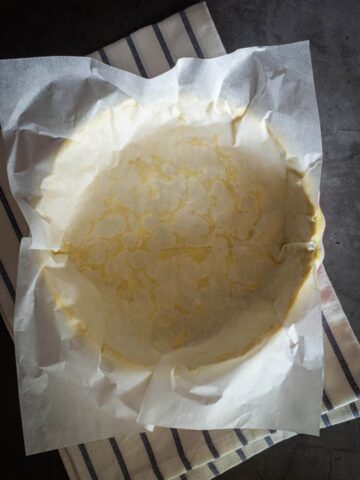
Step 1: Prepare the pie for baking by placing the pie dough in the pie pan and placing a piece of baking paper on top.
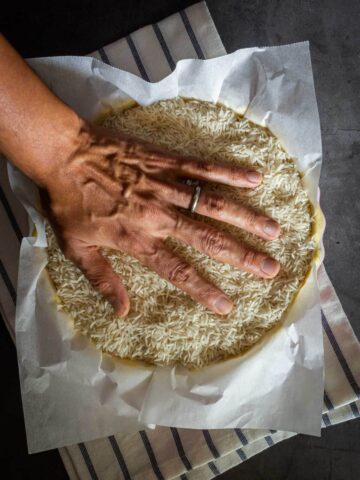
Step 2: Fill it with weight, such as raw rice or pulses, like lentils, rice, or beans. Distribute evenly.

Tip: Only cook the crust until it is lightly browned.
If you follow these tips, your vegan pie will always be perfect! Use this great recipe to get creative with fillings to make sweet pies or a savory pie dish.
👨🏻🍳 To Roll or Not to Roll
You can roll the dough between two pieces of parchment paper with a rolling pin or a clean wine bottle. The parchment paper prevents the dough from sticking to the counters or rolling pin.
I recommend trying this quickly, as you want to keep the temperature low for as long as possible. Once you have placed the shortening crust inside the pan, leave it in the fridge while you work on anything else before proceeding with your pie or tart recipe.
📖 Variation
Rolling the dough over the counter is an option; ensure you work on a lightly floured surface with a floured rolling pin. If you make a GF version, use almond or gluten-free flour.
Another great vegan variation if you want to make a chocolate version is making an Oreo pie crust since Oreo cookies are accidentally vegan! 🙂
🥡 Storing
If you have an excess crust, you can store it in the fridge for up to 3 days—maybe even more—but it just hasn't survived so many days, as you can use it for all pie sizes and tastes.
Make it a ball and use plastic wrap (cling foil) to keep it chilled.
Can you freeze it? YES! That's one of the things I love about this easy vegan pie crust; you can simply place the wrapped dough in the freezer for up to 6 months. When ready to use it, remember to leave it in the refrigerator overnight or for 8 hours. Do not use the microwave. The butter or shortening will melt.
Happy baking, friends!
Make sure you try our Pumpkin pie-inspired recipes, such as pumpkin pie spice mix and overnight oats.
If you like kneading and making your own bread and pizza, check out our traditional Italian Italian artisan bread, Rosemary focaccia bread, simple vegan cheese pizza, and cheese-less Marinara pizza.
📚 More vegan dough recipes
Vegan baking is an art. Let us take you through some delicious creations that won't make you miss butter or eggs!
⭐ If you try this recipe, let us know! 💬 Leave a comment, rate it, and don't forget to tag us @ourplantbasedworld on Instagram. Cheers!
🎥 Video
📋 Recipe

Vegan Pie Crust (No-Roll)
Equipment
Ingredients
- 1 ¼ cups all-purpose flour or gluten-free flour for pie crust, we like Bob's Mill
- 3.5 oz vegan butter diced into ½-inch cubes and chilled* We use unsalted Earth Balance
- ½ teaspoon fine sea salt
- ½ teaspoon brown sugar cane any sugar works
- 2 tablespoons ice water plus more as needed
Directions
- Choose the food processor's plastic spinner (not the blade, which works best with dough).
Make the Dough
- Combine dry ingredients. the flour, salt, and sugar in a food processor. Pulse briefly to combine.1 ¼ cups all-purpose flour, ½ teaspoon fine sea salt, ½ teaspoon brown sugar cane
- Add the cold vegan butter (or margarine) cubes with 2 tablespoons of ice water and turn on at a low speed.3.5 oz vegan butter, 2 tablespoons ice water
- Add the remaining butter through the shut and pulse until it is crumbly.
- Test the dough with your fingertips. If it holds together, it's ready. Add another 1 tablespoon of water if necessary. With 2 total tablespoons, mine is always spot-on; it's up to you.
- Knead. Take the dough out, knead it for a few seconds with your hands, and no more than 30 seconds because the heat from your hands may cause the vegan butter to melt.
Chill in the fridge
- Wrap. If it starts to get sticky, immediately wrap it with plastic wrap.
- Allow chilling for one hour or up to three days.
Stretch in pie pan and Bake
- Use. When you're ready to use the dough, let it sit on the counter for about 15 minutes to make it easier to handle.In case you are also using a top crust for your pie, I like to begin with the bottom crust and leave the second one in the fridge while I work on the first one on the pie pan if I'm making a double-crust pie.
- Simply drop the dough, without stretching it out on a plate or tray first, into the pie dish. It will most likely be crumbly at first, but it will soften and easily stretch in seconds.
- Continue to stretch until you have draped the entire dish with the dough. The pie plate does not need to be greased or dusted. Follow the video and drawing instructions for details on how to make it.
- Pinch. I also like to pinch the dough all over with a fork to ensure that the heat is distributed throughout it.
- Bake. Proceed with your pie recipe. Bake for 55-60 mins, or until it looks lightly golden brown. Turn off the oven and you can let it sit in the oven for 10 minutes with the door slightly open, ensuring your chosen mix sits and you have a fully cooked crust.
Video
Notes
Nutrition Facts
Nutritional Disclaimer
The information shown is an estimate provided by an online nutrition calculator. It should not be considered a substitute for a professional nutritionist's advice. See our full Nutritional Disclosure here.
Affiliate Disclaimer
Please note that some of the links here are affiliate links, and I will earn a commission if you purchase through those links. I recommend all of the products listed because they are companies I have found helpful and trustworthy.
As the lead content writer and recipe developer at Our Plant-Based World, he combines his passion for health and sustainability with a Plant-Based Nutrition Certification to create accessible, delicious vegan recipes. His expertise in plant-based cooking supports the blog's mission of fostering a healthier, environmentally conscious lifestyle through simple and seasonal dishes. His commitment to making vegan cooking enjoyable and inclusive for everyone shines in each recipe and article.


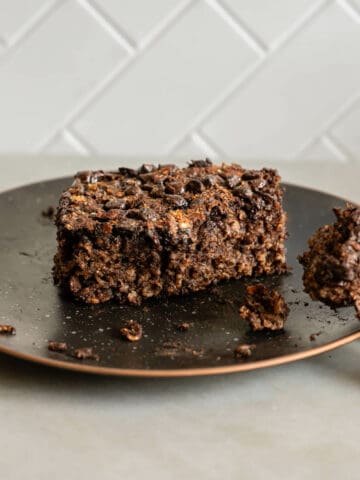

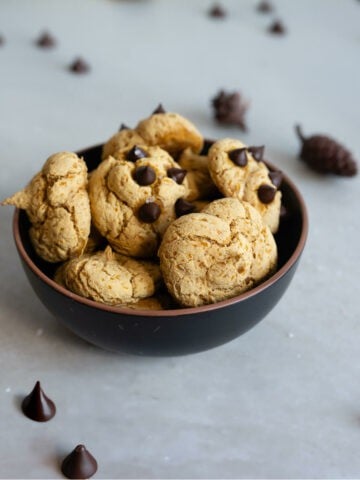
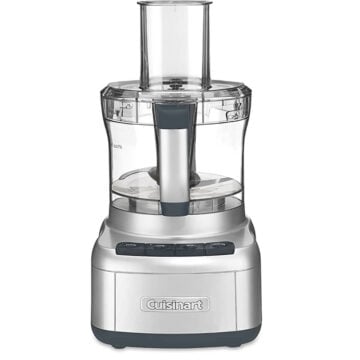
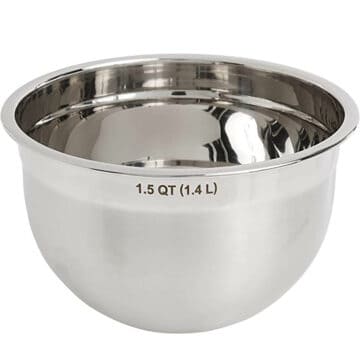
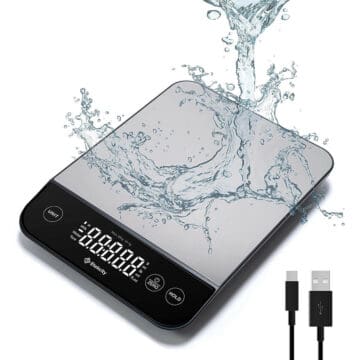

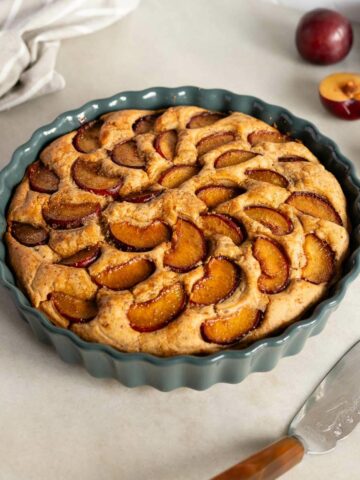

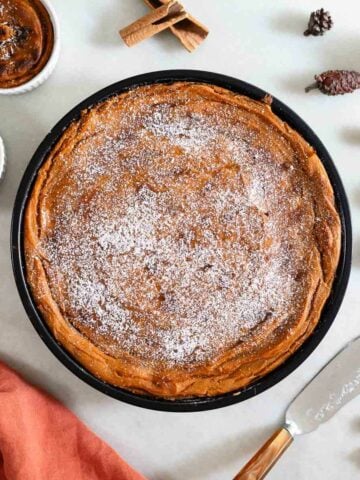
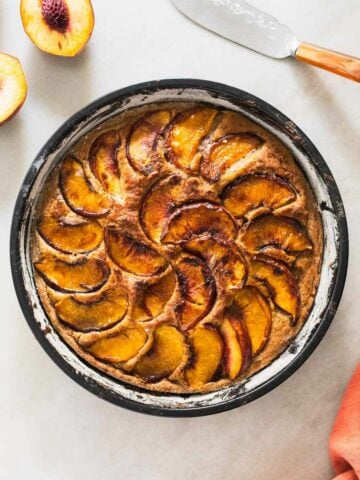
Miriam
This looks like a great recipe but I wish there was a way to print it so it only took up one page. Front and back is fine. Using the print button in the recipe would require using two pages. May I suggest that it is not necessary to include pictures of the equipment. I had to copy and paste the text into a new document and print from that.
Gus
Thank you for your feedback, Mirian. I have gone ahead an made the change so the print version doesn't include any images. Best regards,
Gustavo
Michelle
I love making my own pie crust from scratch! I have to say though, for a newbie the photos and instructions here are SO helpful.